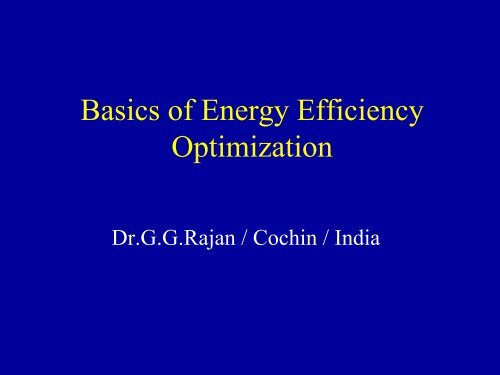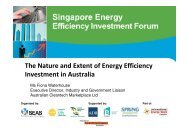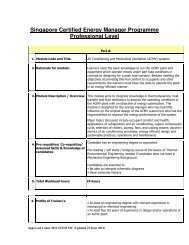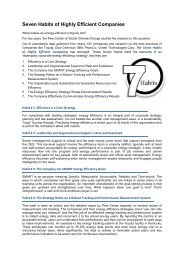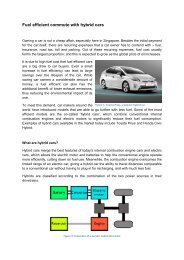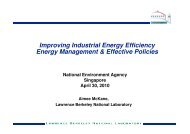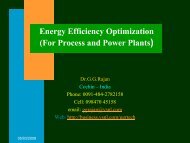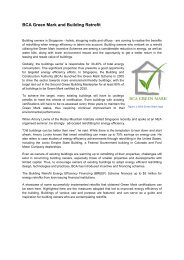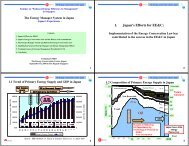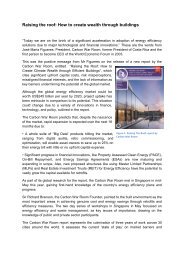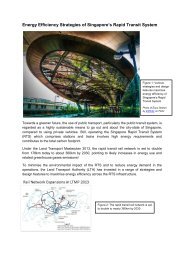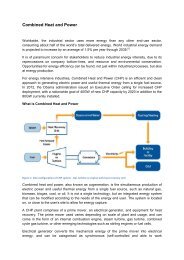Basics of Energy Efficiency Optimization
Basics of Energy Efficiency Optimization
Basics of Energy Efficiency Optimization
Create successful ePaper yourself
Turn your PDF publications into a flip-book with our unique Google optimized e-Paper software.
<strong>Basics</strong> <strong>of</strong> <strong>Energy</strong> <strong>Efficiency</strong><br />
<strong>Optimization</strong><br />
Dr.G.G.Rajan / Cochin / India
What is optimization <br />
All <strong>Optimization</strong> problems are made up <strong>of</strong> three basic<br />
ingredients:<br />
An objective function which we want to minimize or<br />
maximize.<br />
For instance, in a manufacturing process, we might want<br />
to maximize the pr<strong>of</strong>it or minimize the cost.<br />
In fitting experimental data to a user-defined model, we<br />
might minimize the total deviation <strong>of</strong> observed data from<br />
predictions based on the model.<br />
In designing an automobile panel, we might want to<br />
maximize the strength.<br />
Note : The objective function should be quantitative/
Contd …<br />
A set <strong>of</strong> unknowns or variables which affect the<br />
value <strong>of</strong> the objective function.<br />
In the manufacturing problem, the variables<br />
might include the amounts <strong>of</strong> different resources<br />
used or the time spent on each activity.<br />
In fitting-the-data problem, the unknowns are<br />
the parameters that define the model.<br />
In the panel design problem, the variables used<br />
define the shape and dimensions <strong>of</strong> the panel.
Contd…<br />
A set <strong>of</strong> constraints that allow the unknowns to<br />
take on certain values but exclude others.<br />
For the manufacturing problem, it does not make<br />
sense to spend a negative amount <strong>of</strong> time on any<br />
activity, so we constrain all the "time" variables to<br />
be non-negative.<br />
In the panel design problem, we would probably<br />
want to limit the weight <strong>of</strong> the product and to<br />
constrain its shape.
• The optimization problem is then:<br />
• Find values <strong>of</strong> the variables that minimize<br />
or maximize the objective function while<br />
satisfying the constraints.<br />
• Are All these ingredients necessary<br />
• Objective Function :<br />
• Almost all optimization problems have a<br />
single objective function. (When they don't<br />
they can <strong>of</strong>ten be reformulated so that they<br />
do!)
• The two interesting exceptions are<br />
• No objective function.<br />
• In some cases (for example, design <strong>of</strong><br />
integrated circuit layouts), the goal is to find<br />
a set <strong>of</strong> variables that satisfies the constraints<br />
<strong>of</strong> the model.<br />
• The user does not particularly want to<br />
optimize anything so there is no reason to<br />
define an objective function.<br />
• This type <strong>of</strong> problems is usually called a<br />
feasibility problem.
• Multiple objective functions.<br />
• Often, the user would actually like to optimize a<br />
number <strong>of</strong> different objectives at once.<br />
• For instance, in the panel design problem, it would<br />
be nice to minimize weight and maximize strength<br />
simultaneously.<br />
• Usually, the different objectives are not compatible;<br />
the variables that optimize one objective may be far<br />
from optimal for the others.<br />
• In practice, problems with multiple objectives are<br />
reformulated as single-objective problems by either<br />
forming a weighted combination <strong>of</strong> the different<br />
objectives or else replacing some <strong>of</strong> the objectives<br />
by constraints
• These approaches and others are<br />
described as multi-objective<br />
optimization.<br />
•Variables<br />
• These are essential.<br />
• If there are no variables, we cannot<br />
define the objective function and<br />
the problem constraints.
• Constraints<br />
• Constraints are not essential.<br />
• In fact, the field <strong>of</strong> unconstrained optimization is a<br />
large and important one for which a lot <strong>of</strong><br />
algorithms and s<strong>of</strong>tware are available.<br />
• It's been argued that almost all problems really do<br />
have constraints.<br />
• In practice constraints are encountered in day to<br />
day operation <strong>of</strong> the enterprise and these<br />
constraints will have to be necessarily considered<br />
for achieving maximum pr<strong>of</strong>its and productivity.<br />
• It is applicable for all enterprises in the economic<br />
scenario.
<strong>Energy</strong> efficiency optimization<br />
Macro level :<br />
In big corporations / enterprises having a number<br />
<strong>of</strong> process / power plants (e.g: National thermal<br />
power plants), energy efficiency optimization <strong>of</strong> the<br />
total organization will bring down the operating cost,<br />
as this approach increases energy efficiency, reduces<br />
fuel consumption / cost and pollution levels.<br />
National level :<br />
At national level, energy resource mix may be<br />
optimized to meet the energy demand at minimum<br />
cost. This concept can improve national productivity<br />
substantially.
Unit level <strong>Energy</strong> optimization<br />
At unit level energy efficiency optimization, total unit may be<br />
divided into systems,subsystems and equipments.<br />
Their energy consumption / generation data is collected and<br />
evaluated.<br />
Taking the actual constraints imposed, an optimization model<br />
is developed with the objective <strong>of</strong> minimizing energy<br />
consumption and at the same time without loss <strong>of</strong> production.<br />
In modern optimization models, Sulfurous emissions are also<br />
incorporated in the model to optimize the energy resource mix<br />
that will meet all the requisites.<br />
Since this is dynamic, the evaluation must also be carried out<br />
more frequently.
Need for <strong>Energy</strong> <strong>Efficiency</strong> <strong>Optimization</strong><br />
High energy cost produced from primary and secondary<br />
sources, warrant maximization <strong>of</strong> energy efficiency in<br />
production as well as consumption.<br />
In operation <strong>of</strong> boilers, heaters, pumps, compressors, turbines<br />
etc % Load on the equipment has an impact on the energy<br />
efficiency <strong>of</strong> the system.<br />
A typical load vs efficiency is shown in the next slide.<br />
In these equipments, efficiency increases with load, reaches a<br />
maximum and then starts dropping down.<br />
When a number <strong>of</strong> such equipments is in operation, as in<br />
boilers, an optimum operation <strong>of</strong> boilers must be chosen to<br />
minimize energy consumption and operating cost.
How to achieve this <br />
This can be achieved by a systematic<br />
<strong>Energy</strong> Auditing <strong>of</strong> various sections<br />
at both micro level and macro level.<br />
For more details, refer to technical<br />
audit info enclosed in the directory.<br />
Certain examples are presented in<br />
this section for understanding the<br />
optimization methodology.
Single variable optimization<br />
model<br />
This model is <strong>of</strong> the form<br />
eff = a * x 2 + b * x + c<br />
where a,b and c are constants and<br />
x is the % load on the equipment in operation and<br />
eff is the % efficiency <strong>of</strong> the equipment.<br />
The model is developed using the plant data or test<br />
runs in which the load is varied keeping all the other<br />
parameters constant.<br />
The observed efficiency is calculated and the data<br />
entered in the model.
Example<br />
Load %<br />
60<br />
70<br />
80<br />
90<br />
100<br />
110<br />
120<br />
Equipment<br />
<strong>Efficiency</strong> %<br />
60.0<br />
70.0<br />
76.0<br />
82.5<br />
87.0<br />
83.5<br />
80.0
Model<br />
Click on the arrow to run the<br />
model.<br />
Type password as dr.ggr<br />
The input file name is optmdl1<br />
Don’t enter file extension<br />
name.<br />
You may create a file <strong>of</strong> your<br />
own and run the program.<br />
Click on the arrow<br />
to run the program .<br />
Enter<br />
Code: DR.GGR or<br />
dr.ggr to execute the<br />
program
Observed Data vs Model<br />
90.0<br />
85.0<br />
80.0<br />
efficiency %<br />
75.0<br />
70.0<br />
65.0<br />
60.0<br />
60 70 80 90 100 110 120<br />
load %<br />
actual<br />
model
Using models in optimization <strong>of</strong><br />
total system<br />
These simple models are very useful for energy efficiency<br />
optimization <strong>of</strong> the total system.<br />
Consider 4 boilers B1,B2,B3 & B4<br />
Load on boilers x1,x2,x3 & x4 % on design.<br />
Eff % on each model is <strong>of</strong> the form e1= a 1 *x 12 + b 1 * x 1 + c 1<br />
Similar models are generated for other boilers.<br />
Fuel consumption for each boiler = f1 =<br />
(x1/100)*d1*enthalpy *(1/cv)* (100/e1)<br />
cv = fuel calorific value in kcal/kg, enthalpy <strong>of</strong> steam = kcal/kg<br />
steam produced, d1= design capacity in kg/hr, e1 = eff % from model
Total optimization model<br />
Minimize f1+ f2 + f3 + f4<br />
subject to<br />
x1+x2+x3+x4 = demand<br />
x1 >=0.6 * d1<br />
x2 >=1.0 * d2<br />
x2
Two variable model<br />
In this case two opposing parameters have an impact on<br />
efficiency, energy loss or operating cost. The objective is to<br />
optimize the common parameter that will minimize the<br />
operating cost.<br />
Typical example is the insulation thickness.<br />
As the insulation thickness for the same service increases, the<br />
fixed cost component increases.<br />
At the same time, energy loss reduces and cost <strong>of</strong> energy loss<br />
reduces.<br />
Total cost = (cost <strong>of</strong> insulation + energy loss cost ) annualized<br />
The data can be converted into models and optimization carried<br />
out.
Insulation thickness optimization<br />
model<br />
For developing this model, certain calculations will have to<br />
be made.<br />
Total insulation cost for various thickness <strong>of</strong> insulation.<br />
Annualization <strong>of</strong> the fixed cost taking into consideration<br />
the life <strong>of</strong> insulation and interest on capital.<br />
This cost varies with<br />
‣Type <strong>of</strong> insulation material<br />
‣Life <strong>of</strong> insulation material<br />
‣Operation & maintenance costs<br />
‣Insulation efficiency
Cost <strong>of</strong> energy loss for various insulation thickness.<br />
This may be calculated by energy loss divided by cost<br />
<strong>of</strong> energy in US$ / Pounds etc per year.<br />
The loss reduces with insulation thickness.<br />
Cost <strong>of</strong> energy loss is dynamic and varies with the<br />
fuel cost. Hence it is imperative to carry out<br />
optimization <strong>of</strong> the insulation systems more<br />
frequently, especially when the energy cost goes up<br />
disproportionately.<br />
Next slide shows the impact <strong>of</strong> insulation thickness<br />
on operating costs <strong>of</strong> the system.
Impact <strong>of</strong> insulation thickness on<br />
operating costs<br />
160<br />
operating cost '000 us$/yr<br />
140<br />
120<br />
100<br />
80<br />
60<br />
40<br />
20<br />
0<br />
10 20 30 40 50 60 70 80<br />
insulation thickness mm<br />
fixed cost nrg loss total cost<br />
• Pl note fixed cost <strong>of</strong><br />
insulation increases<br />
with thickness and<br />
cost <strong>of</strong> energy loss<br />
reduces.<br />
• Optimum thickness<br />
in this case is 40 mm<br />
at which the total<br />
cost is 110 thousand<br />
us$/yr<br />
• This varies from<br />
system to system
Mathematical model<br />
• This may be converted into a<br />
mathematical model by using<br />
regression methods.<br />
• These models are<br />
• Insulation cost model<br />
• <strong>Energy</strong> loss cost model and<br />
• Total cost model<br />
• Data used in the program is given in<br />
the next slide.
Data used in the model<br />
Insulation<br />
thickness mm<br />
Cost <strong>of</strong><br />
insulation<br />
Cost <strong>of</strong><br />
energy loss<br />
Total<br />
cost<br />
10<br />
10<br />
120<br />
130<br />
20<br />
18<br />
105<br />
123<br />
30<br />
28<br />
88.5<br />
116.5<br />
40<br />
38<br />
70<br />
108<br />
50<br />
49<br />
65<br />
114<br />
60<br />
58<br />
62<br />
120<br />
70<br />
68<br />
60<br />
128<br />
80<br />
78<br />
56<br />
134
Methodology<br />
• There are two methods by which the optimum<br />
insulation thickness may be arrived.<br />
• In the first method, two models are developed<br />
for the insulation cost and energy loss cost. The<br />
first model is linear and the second model is<br />
non-linear.<br />
• These two models are integrated to form the<br />
third and final model.<br />
• This model is used for determining the<br />
optimum insulation thickness. ( use regression<br />
equations to develop the models )
Models<br />
Insulation cost model :<br />
This is <strong>of</strong> the form C 1 = A*x + B<br />
Cost <strong>of</strong> <strong>Energy</strong> loss:<br />
This is <strong>of</strong> the form C 2 = A 2 *x 2 + B 2 * x + C 2<br />
Total Cost model:<br />
This is equal to :<br />
C 1 +C 2 = C = A 2 *x 2 + x * ( A + B 2 ) + ( B + C 2 )<br />
Where A,A 2 ,B 2 ,C & C 2 are constants and x is the insulation<br />
thickness in mm.
Models<br />
160<br />
140<br />
120<br />
'000 US$ / yr<br />
100<br />
80<br />
60<br />
40<br />
20<br />
0<br />
10 20 30 40 50 60 70 80<br />
insulation thickness in mm<br />
insuln cost cost <strong>of</strong> nrg loss total cost
Models for insulation system<br />
Insulation cost model<br />
C 1 = .9845237 * x - .9285644 ( S.E. 0.5989)<br />
Cost <strong>of</strong> <strong>Energy</strong> Loss model<br />
C 2 = 1.610116E-02 * x 2 - 2.350891* x + 143.0446<br />
(S.E. : 2.4601)<br />
Total cost model C t = C 1 + C 2<br />
= 1.610116E-02 * x 2 – 1.366673 * x + 142.1160356<br />
For determining minimum total cost, total cost function is differentiated<br />
WRT x and equated to 0.<br />
When second order differential is –ve, then x represents the thickness at<br />
which the total cost is minimum.
dc t /dx = 2 * (1.610116E-02 ) * x – 1.366673 = 0<br />
i.e. 2 * 0.01610116 * x = 1.366673<br />
i.e. x = 1.366673 / (2 * 0.01610116) = 42.44 mm<br />
d 2 c t /dx 2 = 0.03220232 ( + ve)<br />
Hence c t is minimum at x = 42.44 mm<br />
Total cost c t = 1.610116E-02 * (42.44) 2 – 1.366673 * (42.44)<br />
+ 142.1160356<br />
= 113.115 ‘000 US$<br />
Refer to earlier slide and note the minimum point is between<br />
40 to 45 mm thickness.
Time dependant model<br />
• While the model given in this section refers<br />
to a totally new scheme, there is a need to<br />
change / replace insulation after certain<br />
period <strong>of</strong> time, because <strong>of</strong> the deterioration<br />
<strong>of</strong> insulation material and increase in heat<br />
loss.<br />
• Next figure shows the optimum replacement<br />
time for the insulation, based on the energy<br />
loss data.
Rs '000000<br />
18<br />
16<br />
14<br />
12<br />
10<br />
8<br />
6<br />
4<br />
2<br />
0<br />
1 2 3 4<br />
year<br />
heat loss opr.cost savings
When the number <strong>of</strong> variables are more, the<br />
objective function will be generated using<br />
the operating data and converting them into<br />
appropriate models.<br />
Then these models may be used in LP or<br />
NLP programs to optimize the objective<br />
function, within the stipulated constraints.<br />
Refer to the book ‘Practical <strong>Energy</strong><br />
<strong>Efficiency</strong> <strong>Optimization</strong>’ by Dr.G.G.Rajan<br />
for more details


